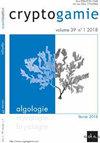英伦三岛Streblocladieae和Polysiphonieae (Rhodomelaceae, rhodophyia)部落的分子鉴定揭示了需要修订分类的新记录和新物种
IF 1.5
4区 生物学
Q3 MARINE & FRESHWATER BIOLOGY
引用次数: 7
摘要
分子工具的使用往往表明,区域物种多样性与我们从基于形态鉴定的评估中所知道的不同。从18 - 19世纪发表的基础工作到最近基于分子工具的修订,英伦三岛的海藻植物群已经在很长一段时间内得到了很好的建立。利用这些工具(主要是rbcL序列),结合形态学观察,对不列颠群岛的Streblocladieae和Polysiphonieae部落进行了研究,使我们获得了三个新的物种记录,以及两个需要分类修订的物种。Polysiphonia morrowii Harvey, P. delicata Díaz-Tapia和Vertebrata tripinnata (Harvey) Kuntze首次在不列颠群岛被记录。发现P. morrowii和P. delicata这两种被认为是在欧洲引进或隐生的物种并不令人惊讶,这些新记录提高了我们对它们分布的认识。三羽脊椎动物以前在南欧有记录,在爱尔兰北部海岸收集它大大扩大了它已知的分布。我们还发现,形态不同的V. simulans (Harvey) Kuntze和P. ceramiiformis P. crouan & H.Crouan(从未转移到脊椎动物)在不列颠群岛的rbcL和cox1序列是相同的,我们建议将后者归约为前者的同义词。最后,我们在形态学上归属于V. fruticulosa (Wulfen) Kuntze的标本中发现了两个伪隐种,并提出了V. martensiana (k本文章由计算机程序翻译,如有差异,请以英文原文为准。
Molecular Assessment of the Tribes Streblocladieae and Polysiphonieae (Rhodomelaceae, Rhodophyta) in the British Isles Reveals New Records and Species that Require Taxonomic Revision
ABSTRACT The use of molecular tools often shows that regional species diversity differs from what we know from assessments based on morphological identifications. The seaweed flora of the British Isles has been well established over a long period from foundational work published during the XVIII-XIX centuries to more recent revisions based on molecular tools. The application of these tools (primarily rbcL sequences), alongside morphological observations, to the study of the tribes Streblocladieae and Polysiphonieae in the British Isles led us to three new records of species, as well as two species that require taxonomic revision. Polysiphonia morrowii Harvey, P. delicata Díaz-Tapia and Vertebrata tripinnata (Harvey) Kuntze are recorded for the first time in the British Isles. Finding P. morrowii and P. delicata, which are considered introduced or cryptogenic in Europe, is not surprising and these new records improve our knowledge of their distribution. Vertebrata tripinnata had previously been recorded in southern Europe and collecting it on the northern coast of Ireland considerably expands its known distribution. We also found that rbcL and cox1 sequences for the morphologically divergent V. simulans (Harvey) Kuntze and P. ceramiiformis P.Crouan & H.Crouan (which has never been transferred to Vertebrata) from the British Isles were identical, and we propose to reduce the latter to a synonym of the former. Finally, we found two pseudo-cryptic species represented in specimens morphologically assigned to V. fruticulosa (Wulfen) Kuntze, and we propose the resurrection of V. martensiana (Kützing) Piñeiro-Corbeira, Maggs & Díaz-Tapia. This work further evidences the relevance of reassessing red algal species diversity using molecular tools, even in regions where floras are considered well-known.
求助全文
通过发布文献求助,成功后即可免费获取论文全文。
去求助
来源期刊

Cryptogamie Algologie
生物-海洋与淡水生物学
CiteScore
2.60
自引率
7.70%
发文量
11
审稿时长
>12 weeks
期刊介绍:
Cryptogamie is a fast-track and peer-reviewed journal of international scope publishing in English only. It accepts original papers and review articles on the taxonomy, biology and ecology of all cryptogams. An issue of Cryptogamie may be devoted to a single topic, under the responsibility of guest editor(s). All articles published in Cryptogamie are compliant with the different nomenclatural codes. A copyright assignment will be signed by the authors before publication.
Cryptogamie, Algologie accepts articles on systematics as well as ecology and evolution of any kind of algae (including Cyanobacteria).
 求助内容:
求助内容: 应助结果提醒方式:
应助结果提醒方式:


